August 17th, 2017 Each week we’ll be posting a photograph from University Archives that shows a scene from KU’s past. We’ve also scanned more than 34,800 images from KU’s University Archives and made them available online; be sure to check them out!
Today is Move-In Day, and new and returning Jayhawks are arriving on Mount Oread. This week’s post features a verbal description and visual depiction of what this looked like at the beginning of KU’s 1928-1929 academic year, according to the 1929 Jayhawker yearbook.
Happy greetings…hand shaking…taxis whizzing away loaded with newly arrived students…perspiring baggagemen swearing at an avalanche of trunks and suitcases…The sleepy town of Lawrence suddenly awakened to the realization that another nine months session had begun at K.U.
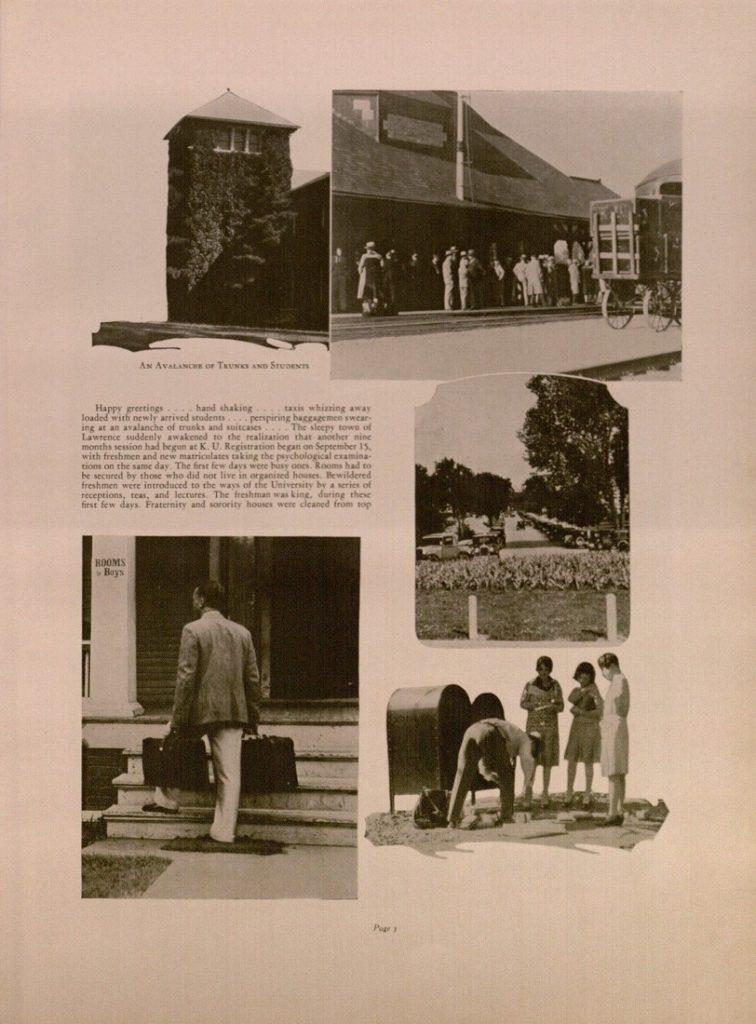
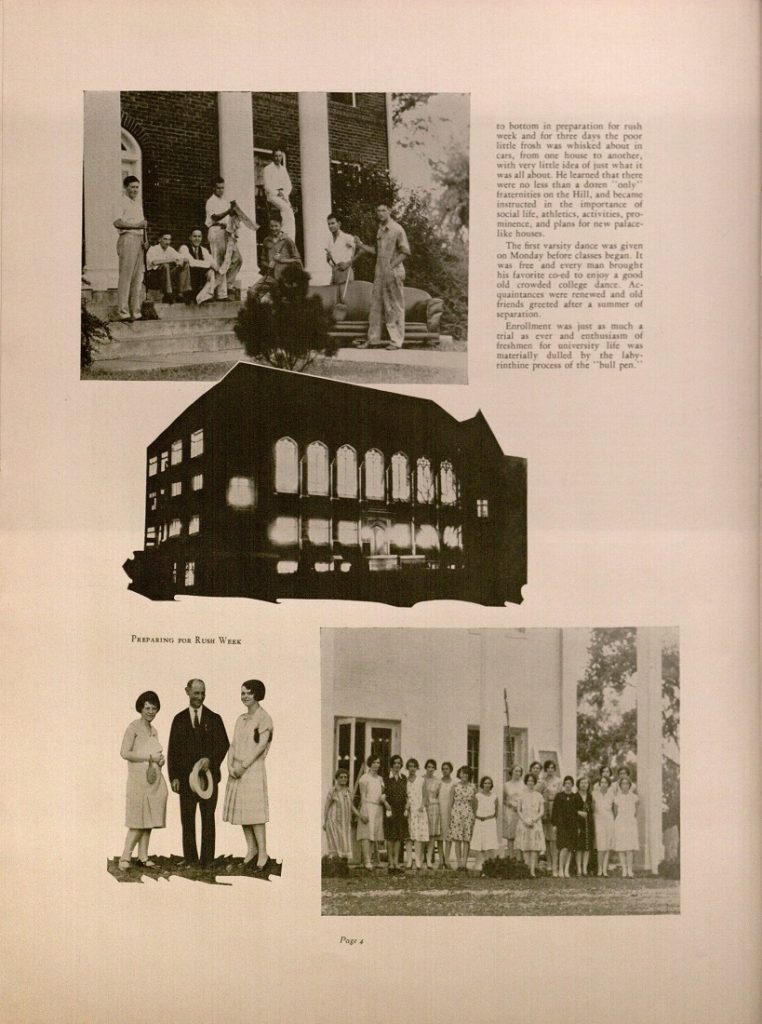
Selected pages from the 1929 Jayhawker yearbook. University Archives.
Call Number: LD 2697 .J3 1929. Click images to enlarge.
Subsequent pages in the yearbook describe the high points of the first week of freshman life at KU. Some events are familiar to modern students, for example participating in fraternity and sorority recruitment and learning about university customs and traditions. Other events – like taking a psychological examination, attending teas, and registering and enrolling for fall classes right before the beginning of the semester – would be foreign.
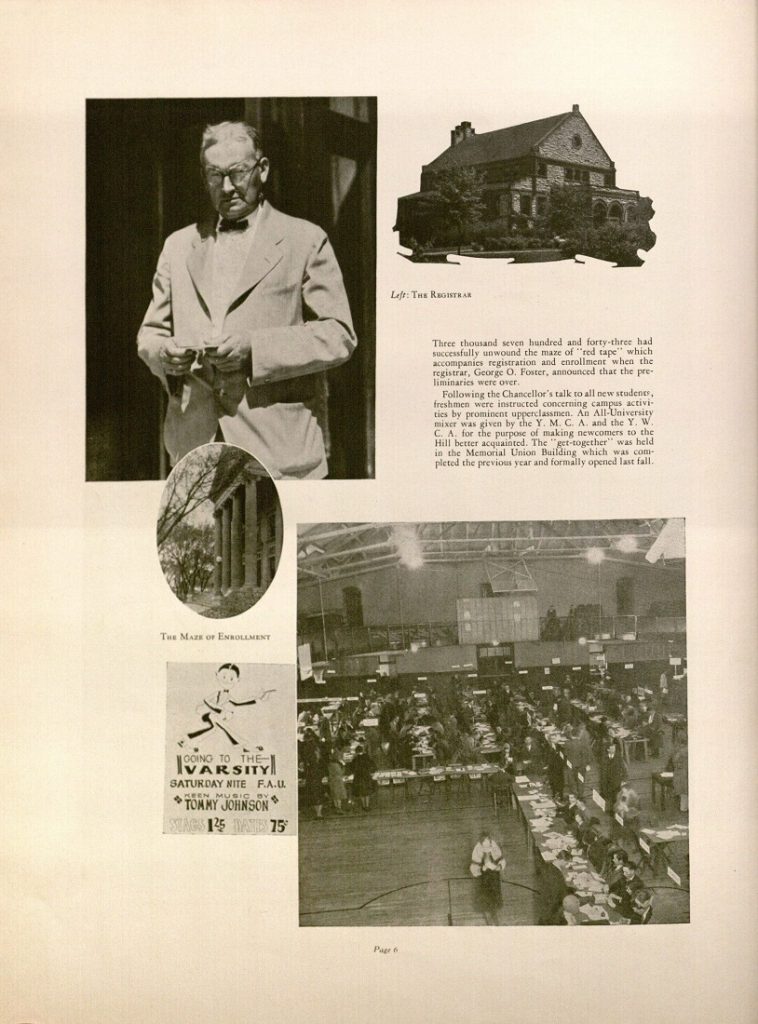
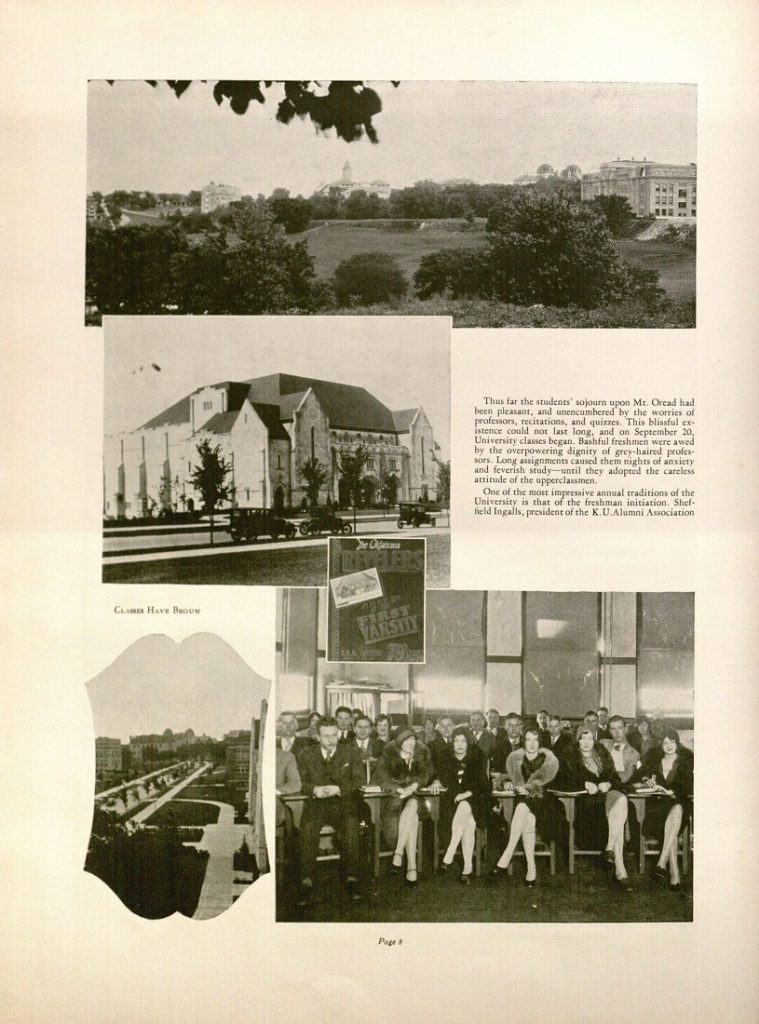

Selected pages from the 1929 Jayhawker yearbook. University Archives.
Call Number: LD 2697 .J3 1929. Click images to enlarge.
Caitlin Donnelly
Head of Public Services
Tags: Caitlin Donnelly, Campus, Enrollment, Fraternities, Hawk Week, Housing, Jayhawker, KU History, Move In Day, photographs, Sororities, Students, Throwback Thursday, University Archives, University history, University of Kansas
Posted in Throwback Thursday |
No Comments Yet »
May 15th, 2017 In December 1917, the University of Kansas Alumni Association’s Graduate Magazine began publishing letters from Jayhawks serving in various capacities overseas. The letters became a regular part of the publication in 1918 and 1919. While some of the letters were from former students to faculty at KU or to The Graduate Magazine itself, most were sent to their families and later shared with the Alumni Association’s publication – giving those back home a glimpse into the lives of brave Jayhawks overseas.
For example, Herbert Laslett was a psychology major in the College of Liberal Arts and Sciences who graduated from KU in 1918. During his final year at KU, he was a student officer in the KU Cadet Regiment. While in Europe as a member of the 353rd Infantry, A.E.F., Laslett wrote to one of his former instructors describing his experience and sharing some news of other former students as well. His letter appeared in the December 1918 issue of The Graduate Magazine.

The KU Cadet Regiment in the Jayhawker yearbook, 1918.
Herbert Laslett is in the back row on the far left.
University Archives. Call Number: LD 2697 .J3 1918.
Click image to enlarge.
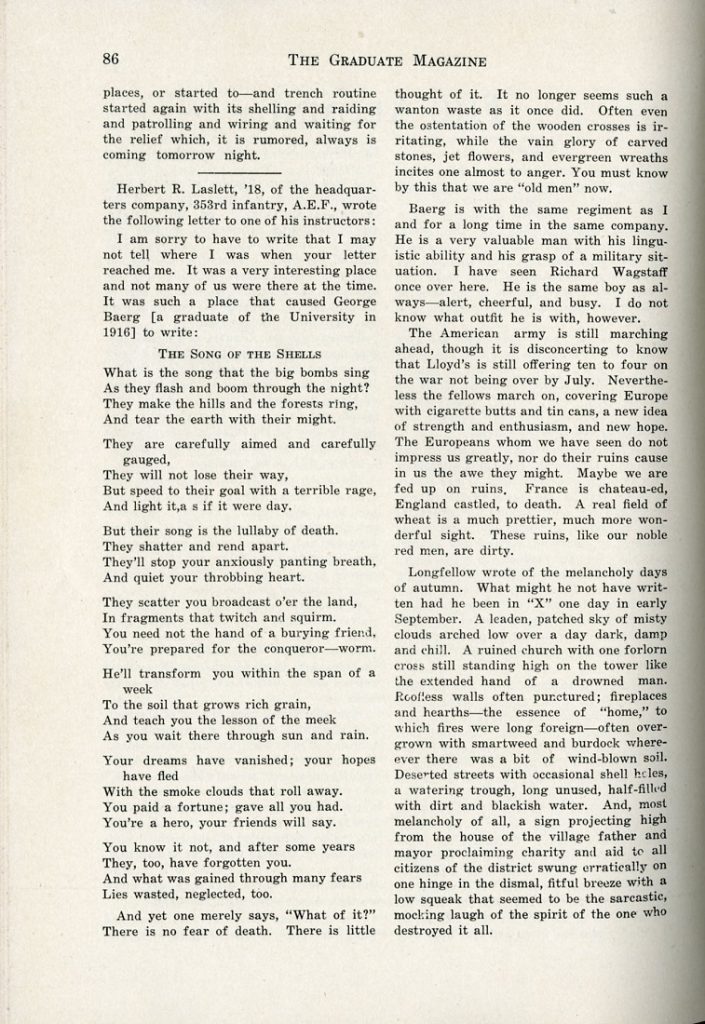
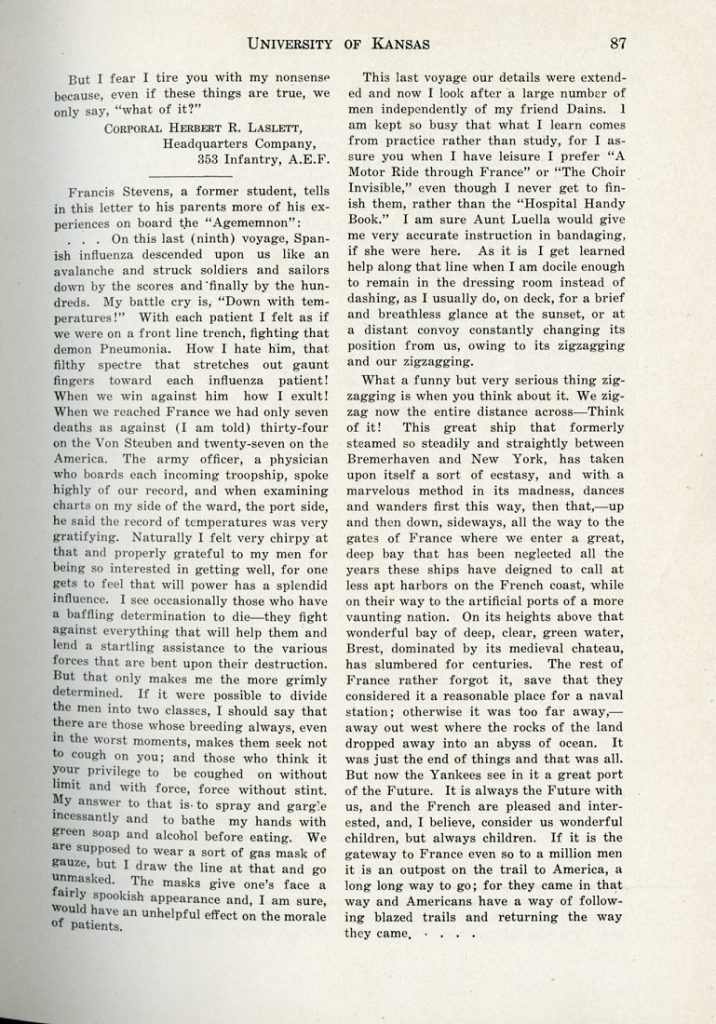
Herbert Laslett’s letters in The Graduate Magazine, December 1918.
University Archives. Call Number: LH 1 .K3 G73 1918. Click images to enlarge.
Evadne Laptad was a student in the College of Liberal Arts and Science who graduated from KU in 1908. Evadne worked as a hospital searcher with the American Red Cross’s Hospital and Home Communication Service during the war. A new initiative during World War I, the Hospital and Home Communication Service sent American women to military hospitals in Europe during and after the war. These women relayed information about injured soldiers to their family and friends back home. Her letter appeared in the April 1919 issue of The Graduate Magazine alongside letters from two other female graduates who were serving the war effort overseas.
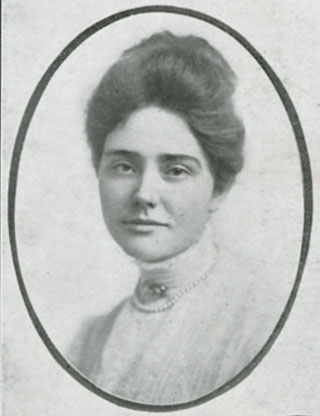
Evadne Laptad’s senior picture in the Jayhawker yearbook, 1908.
University Archives. Call Number: LD 2697 .J3 1908.


Evadne Laptad’s letters in The Graduate Magazine, April 1919.
University Archives. Call Number: LH 1 .K3 G73 1918. Click images to enlarge.
Emily Beran
Public Services
Tags: correspondence, Emily Beran, Evadne Laptad, Graduate Magazine, Herbert Laslett, Jayhawker, KU History, photographs, Students, University Archives, University history, University of Kansas, World War I
Posted in University Archives |
No Comments Yet »
May 3rd, 2017 Pulitzer Prize and Academy Award-winning playwright and screenwriter William Inge (1913-1973) was born on this day in Independence, Kansas, 104 years ago.

William Inge, circa 1960. University Archives Photos.
Call Number: P/ Inge, William (Photos). Click image to enlarge.
Inge attended the University of Kansas from 1930 to 1935, getting his degree in speech and dramatic arts. While a student, Inge pursued his interest in acting as a member of the KU Dramatics Club. In the fall of 1934 he was in a KU production of Eva the Fifth, the story of a traveling theater troupe.

William Inge and Virginia Hecker in a scene from Eva the Fifth, Fall 1934.
This photograph appeared in the Topeka Capital Journal, October 19, 1963.
William Inge biographical file. University Archives. Click image to enlarge.

Inge was a also member of Sigma Nu while at KU.
This picture of him is from the fraternity’s
group photo in the 1935 Jayhawker yearbook.
University Archives. Call Number: LD 2697 .J3 1935.
Click image to enlarge.
Inge turned his attention to playwriting after leaving KU and was quite successful. His most well-known works are Come Back Little Sheba, Picnic, Bus Stop, Splendor in the Grass, and The Dark at the Top of the Stairs.
Inge came back to KU several times as a guest lecturer, and in 1955 he directed a KU production of what would become Picnic, using an early draft version of the play entitled Summer Brave.

Cover page of Inge’s “Summer Brave,” 1961.
Call Number: RH MS D70. Click image to enlarge.
Spencer Research Library has a small Inge Collection, and the William Inge Memorial Theatre, housed in Murphy Hall on the KU campus, is named in his honor. The largest collection of Inge materials is housed at Independence Community College, where there is also the William Inge Center for the Arts and an annual William Inge Theater Festival.
Kathy Lafferty
Public Services
Tags: Jayhawker, Kansas Collection, Kathy Lafferty, Sigma Nu, Students, University Archives, William Inge
Posted in Kansas Collection, University Archives |
No Comments Yet »
March 20th, 2017 Members of the University of Kansas’s faculty involved themselves in the World War I war effort in a multitude of ways, including military and government service. By 1918, thirty-one members of the faculty were actively engaged in some type of war work. Here are some highlights of their efforts from the University Archives.
School of Engineering
Dean Perley F. Walker left his position and joined the Army when the United States entered the war. He entered the service as Major, but shortly thereafter was promoted to Lieutenant Colonel.
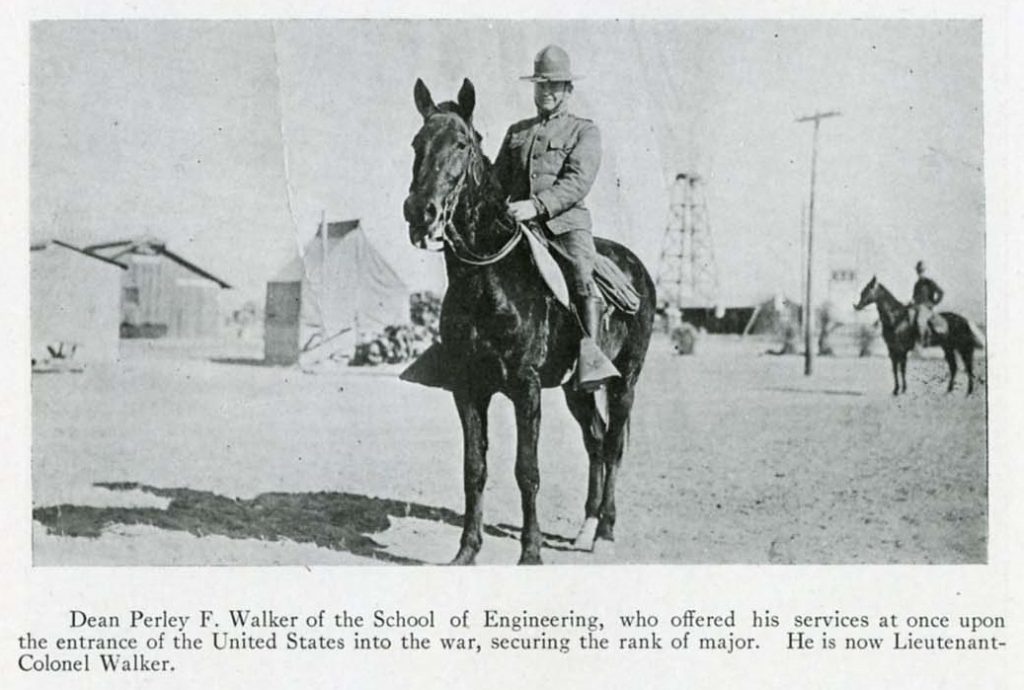
Perley Walker in the Jayhawker yearbook, 1918. University Archives.
Call Number: LD 2697 .J3 1918. Click image to enlarge.
Department of Physical Education
Several members of the Physical Education staff joined the Armed Forces during WWI, including coaches George Clark, Leon McCarty, and Herman Olcott. In addition to those faculty members who enlisted, the Department of Physical Education also saw Dr. James Naismith leave to work with the Y.M.C.A. in France.
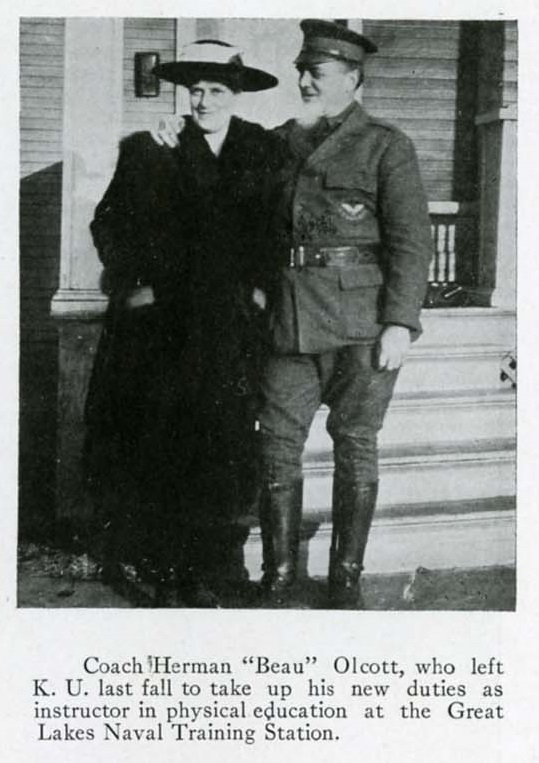
Herman Olcott in the Jayhawker yearbook, 1918.
University Archives. Call Number: LD 2697 .J3 1918.
Click image to enlarge.
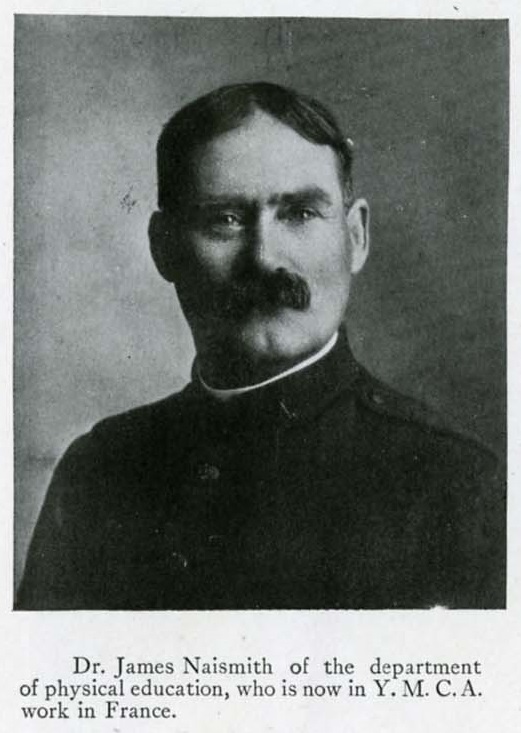
James Naismith in the Jayhawker yearbook, 1918.
University Archives. Call Number: LD 2697 .J3 1918.
Click image to enlarge.
College of Liberal Arts and Sciences
Military service was not the only thing that pulled faculty away from the University of Kansas. Dean Olin Templin took a temporary leave to organize and supervise the War League of American Colleges – an idea originated by Dean Templin. The goal of the organization was to educate college students across the country about the significance of the war and to prepare them for the future changes that would impact them as a result of the conflict.
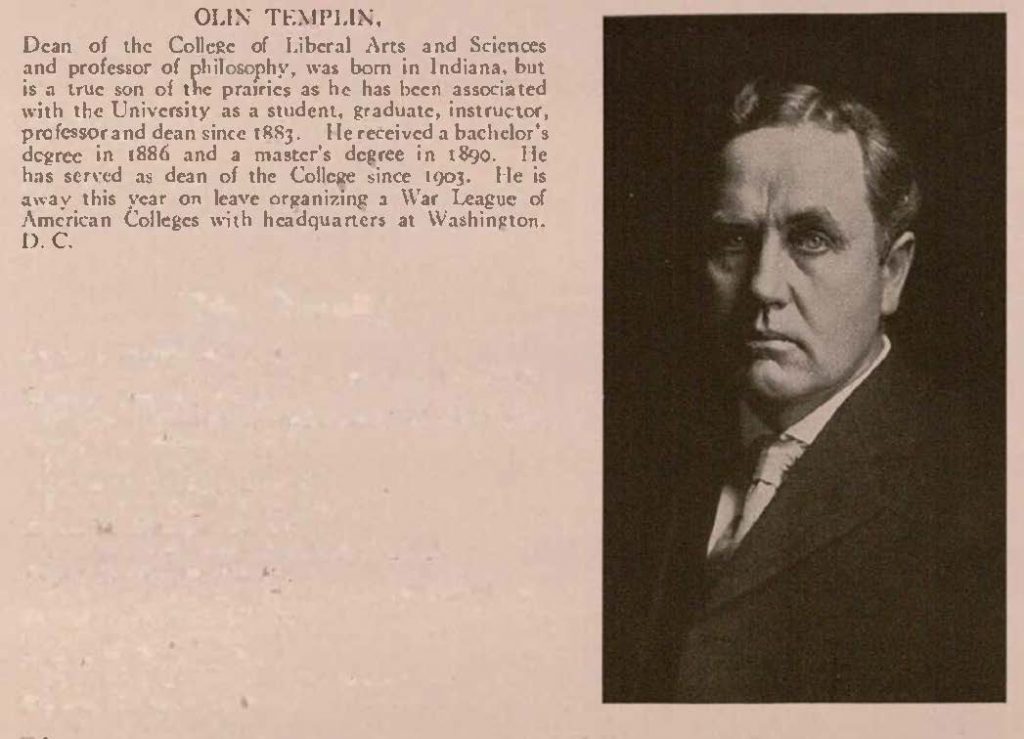
Olin Templin in the Jayhawker yearbook, 1918. University Archives.
Call Number: LD 2697 .J3 1918. Click image to enlarge.
For additional information regarding the University of Kansas during World War I, please visit Spencer Research Library and explore our University Archives collections – including items such as issues of the Graduate Magazine, Jayhawker yearbooks, and ROTC records!
Emily Beran
Library Assistant
Public Services
Tags: Emily Beran, Faculty, Herman Olcott, James Naismith, Jayhawker, KU History, Olin Templin, Perley F. Walker, University Archives, University history, University of Kansas, World War I, Yearbooks
Posted in University Archives |
No Comments Yet »
December 12th, 2016 Women at the University of Kansas contributed to the war effort in a variety of ways during World War I. Here’s a look at just some of the ways that KU women found to support the war effort, as illustrated by the collections in University Archives!
The physical education and English departments made their mark on the war effort through several organized projects. Students in various knitting and sewing classes made sheets and bed socks for hospitals and sweaters for the troops. Knitting classes were later disbanded temporarily to allow time and space for female students to make surgical dressings for military hospitals.
In addition, many women on campus also became involved with the Red Cross during the war via courses in home nursing and Red Cross organization and home relief.

A surgical dressing class at KU, Jayhawker yearbook, 1918.
University Archives. Call Number: LD 2697 .J3 1918. Click image to enlarge.

Surgical dressing and Red Cross pamphlet in the Florence Harkrader scrapbook, 1916-1919.
University Archives. Call Number: SB 71/99. Click image to enlarge.
Food use and conservation was of utmost importance to the war effort. As Herbert Hoover, Director of the U.S. Food Administration during World War I, said: “if food fails, everything fails.” The need to educate the public on food conservation prompted the Food Administration to begin offering lectures and courses about food use and conservation at universities around the country, including KU. All female students at the University attended these lectures, entitled “Food and the War.”
With so many men enlisted in the Armed Forces, it fell to women and younger men to fill vacant positions in the work force here in the United States. Several female students enrolled in stenography, typewriting, and telegraphy courses through the University and the Lawrence Business College.

Advertisement for the Lawrence Business College,
Jayhawker yearbook, 1918. University Archives.
Call Number: LD 2697 .J3 1918. Click image to enlarge.
For additional information regarding the University of Kansas during World War I, please visit the Spencer Research Library and explore our University Archives collections – including items such as issues of The Graduate Magazine and Jayhawker yearbooks!
Emily Beran
Library Assistant
Public Services
Tags: Emily Beran, Florence Harkrader, Jayhawker, KU History, Lawrence Business College, Red Cross, University Archives, University history, University of Kansas, World War I
Posted in University Archives |
No Comments Yet »






















